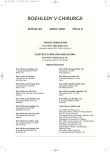Intracranial Meningiomas – Criteria for Selection of the Optimum Therapeutic Modality
Authors:
P. Kozler 1; F. Kramář 1; V. Beneš 1; F. Charvát 2
Authors‘ workplace:
Neurochirurgická klinika 1. LF UK a ÚVN, Subkatedra neurochirurgie IPVZ Praha
přednosta plk. prof. MUDr. V. Beneš, DrSc.
1; Radiodiagnostické oddělení ÚVN Praha, přednosta pplk. MUDr. F. Charvát
2
Published in:
Rozhl. Chir., 2005, roč. 84, č. 8, s. 383-391.
Category:
Monothematic special - Original
Overview
The authors present their own proposal for a standard diagnostic procedure algorithm in intracranial meningiomas, which they used in their prospective, non-randomized longitudinal study in a group of 30 subjects within a year. The following four criteria were assessed in each patient: age, physical condition according the ASA classification, location of the meningioma on the MRI (superficial, the scull base) and the growth invasivity using selective DSA (ACI+ACE) and MRI (the vascularization type, the oedema index and the change in the oedema signal intensity in 3.5 hours). The criteria helped to establish the optimum therapeutic procedure for each patient: embolisation without a follow-up surgery (2 subjects), observation (2 subjects), pre-operative embolisation (5 subjects) and surgery without preceeding embolisation (21 subjects). This study did not assess the intracranial meningiomas treatment outcome. It highlights significance of the diagnostic procedures standardization in order to establish their optimum therapeutic modality.
Key words:
intracranial meningioma – ASA – growth invasivity – embolisation – MRI – selective DSA
Labels
Surgery Orthopaedics Trauma surgeryArticle was published in
Perspectives in Surgery

2005 Issue 8
Most read in this issue
- Laparoscopic Surgical Procedures in Children with the Hirschprung’s Disease – Initial Experience
- Analysis of Surgical Procedures on the Vena Saphena Magna in the Czech Republic and an Effect of Detralex during its Stripping
- Modification of Surgical Treatment of Ingrowing Toenail
- Contemporary Trends in the Thoracic Surgery View to the History, Perspective
